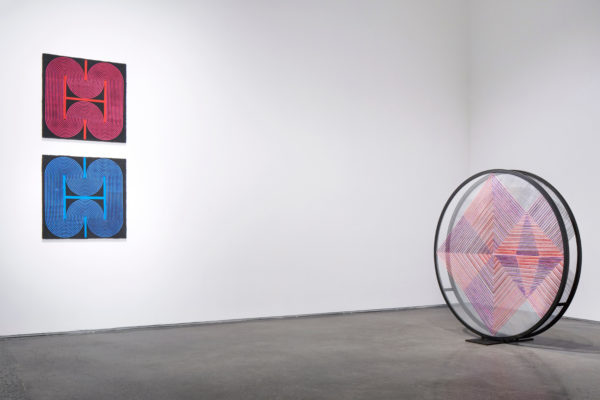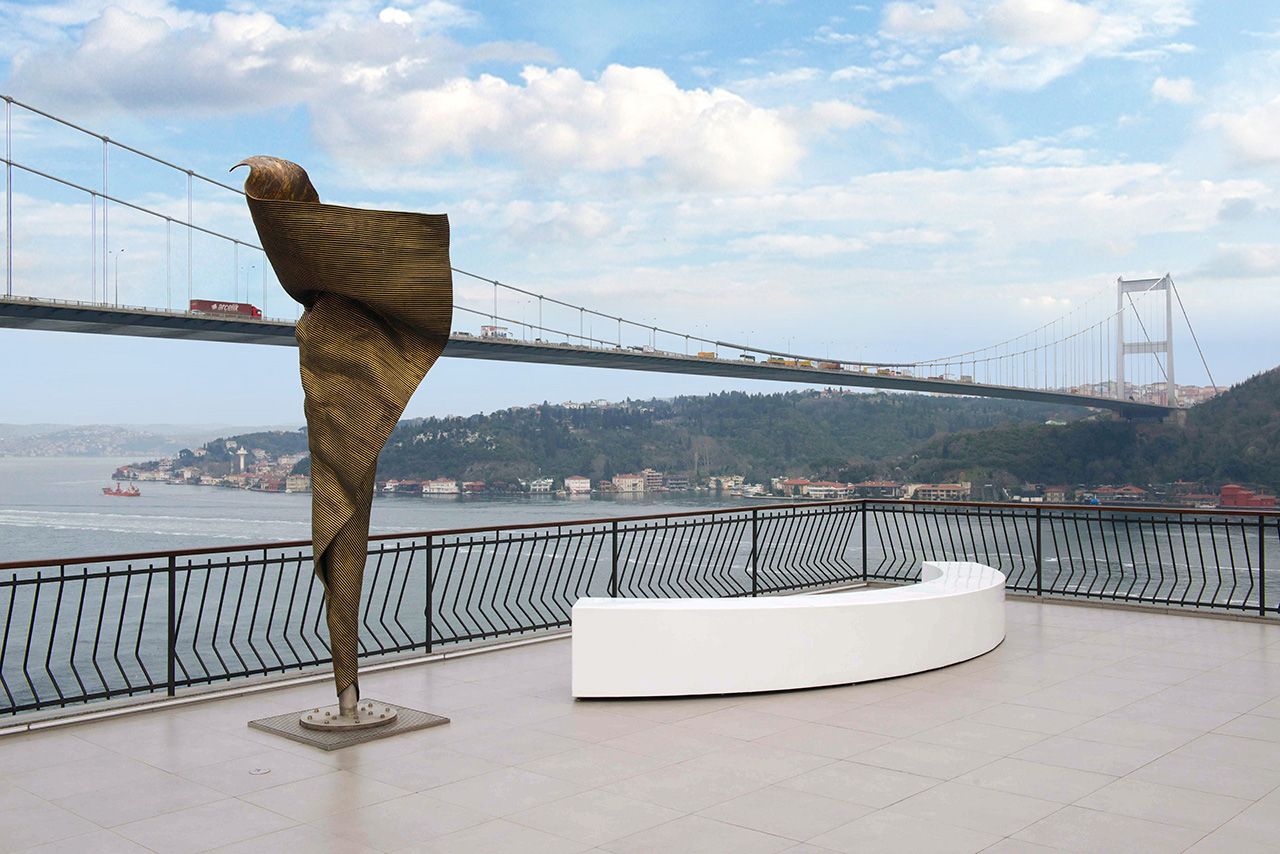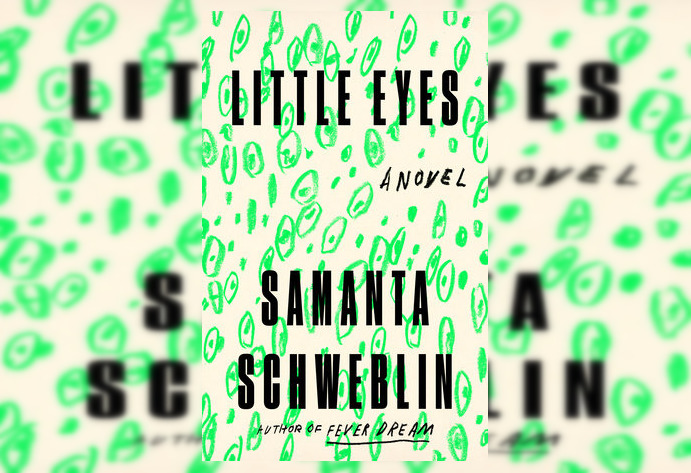Hard Edges: Lorser Feitelson, Elise Ferguson, Alois Kronschlaeger (1 March – 14 April 2018)
Hard Edges is a two-person show (arguably three) of new work by the New York based artists, Elise Ferguson (b. 1964) and Alois Kronshlaeger (b. 1966), at Cristin Tierney Gallery. While Ferguson’s and Kronschlaeger’s practice are not in direct conversation with one another, the two “drink from the same well,” so to speak. This is a well spiked with a few big names and themes: the color theory of Josef Albers, the concentric lines of early Frank Stella, and the irregular shapes and flat color planes of Ellsworth Kelly. Yet the clearer communal source is Latin American Abstraction: the Lygias – Clark and Pape, Jesús Rafael Soto, and the Mexican painter, Eduardo Terrazas – who Alois swoons for and whose direct influence Elise does not deny.
I met Alois last June when he first began experimenting with yarn. The product of his experiments was showcased in a solo show at Cristin Tierney back in the fall. The gallery was filled with Alois’s geometric screen drawings crafted out of hand-dyed Merino wool threaded through rectangular window screens. The viewer was invited to move the screens on their hinges to explore the optics of the fiber, color, and graphic designs.
The works currently on display build off of this early exploration. Alois exchanges the rectangular frames for circular ones. He enthusiastically encouraged the shift the day he brought home the four-foot tall firewood rack he found on the street with his wife, Florencia, on one of their late night walks around Williamsburg. The remnants of the rack are revealed amongst the three custom-made carbon steel frames: one mounted on the gallery wall and the other two welded together at the base to produce a psychedelic yarn extravaganza.
With the circular cut mesh, the threaded compositions become more rhythmic and fluid. The increased scale allows Alois to play with the yarn like “bubble-gum” or “dough.” Drawing the lines in and out of the mesh, the seemingly two-dimensional planes become volumetric to the viewer. The color palettes ooze together, whether carefully died shades of red or readymade purple, the colored wool tricks the eye as assorted zigzags and triangles float slowly in space. The colors, icy blue and white, or red and yellow, become grey and orange. All chosen for their vibrancy, changing with the density of the light and all inspired by Alois’s love affair with Mexico City.

The hinges – once the source of support and limited range of motion for the window screens – are now what join the five panel drawings, or fancy “room divider” standing tall on the gallery floor. The viewer is meant to get physical – extending and contracting the panels to view a series of compositional variations. On view it remains fixed at its maximum expansion.
While Alois has been working with Cristin Tierney Gallery since the gallery opened in 2010, Elise is a newer addition (although not officially represented by the gallery). Alois stumbled upon Elise’s work back in 2014 at EXPO Chicago and insisted Cristin, the gallery’s owner, check her out. Cristin quickly got on board, putting Elise in a group show and bringing her work to Zona Maco in Mexico City.

When viewing Elise’s work, there’s no mystery about what caught Alois’s eye: the optics of line, color and form. The work’s geometric similarities to one of Alois’s favorites – the Terrazas and Lance Wyman poster for the Mexico City 1968 Olympics – made Elise’s work an equally fun find. The aesthetically harmonious compositions read like letters or code. Akin to Alois’s yarn drawings, the colored patterns jump out at you while the matte surface, not unlike the mesh screens, sinks into the wall.
When first approaching her work, I quickly noticed the jagged edges. The panel appears to float in space – as if the rectangular board had been sawed out of the gallery wall. I tried to look behind the object to find the source of the support – the pleasure of viewing works at a gallery with no security guards or interns watching your every move. Nothing was revealed.
I had only glimpsed Elise’s work prior to the shows opening – a few photos Alois showed me during a studio visit and then what Elise would reveal to her instagram followers. Practically everything is lost on the digital screen. The weightlessness, the glitches, errors and overlaps. From a distance or on a screen you would think her works are mechanically produced. Early on it becomes clear that a human hand touched and handled this object. A human hand that Alois describes as “kickass.”
Elise lives up to her “kickass” reputation. She manages to use words like “delightful” and “dude” in the same sentence. Thirty minutes before our meeting she offered to pick me up. It took me a moment to realize she meant in her car. She’s one of those New Yorkers that has miraculously managed to figure out a way to drive between the Boroughs and enjoy it. At the coffee shop I was stationed at, cramming for my visit, a man kept looking over at me and then eventually asked: “is that Elise Ferguson’s work?” He said he was a fan so I directed him to Cristin Tierney Gallery and another show she’s having right now at 57W57 ARTS.

Before we drove to her studio in Greenpoint we made a pit stop at Cleopatra’s to see some photographs by Matthew Spiegelman while he whipped up two cortados. On our way back to the car Elise said she felt like she was on some fancy Vanity Fair interview – popping around the city before we get to the nitty-gritty.
Once in her studio I got the low-down. The sculptural quality in Elise’s work is subtle, but her process even more so. For all intents and purposes, the works function as paintings, but referring to them as objects, or even “things,” feels more appropriate. Elise is all about the layering. Her process begins on Photoshop, working with the same geo-shape patterns – either her signature “X’s” or signature “O’s” (at Cristin Tierney we see the “O’s”) – and toying with varying designs and color sequences. When she’s satisfied she will print them out on flimsy inkjet paper to confirm or deny her satisfaction. She confesses many end up in the trash.
On a thin board Elise trowels ten to fifteen thin layers of Venetian plaster to create a thick, but delicate, matte foundation. She pushes an old yudu silkscreen through the plaster creating a topographical effect before the design is planted on top. The application is intentionally messy. There are visible ink misalignments and overlaps. The product, she says, resembles the difference between a “real Persian rug and one sold at Home Depot.” The loose threads are crucial to her practice and what most distinguishes her from the type-A Austrian behind the immaculate yarn on the neighboring wall.
The two-person show was decided on back in October when Alois’s solo show was still up at Cristin Tierney. To contextualize Ferguson’s and Kronshlaeger’s new bodies of work, the three – two artists and dealer – agreed to throw a historical figure into the mix.
The choices seem endless when you are promoting two contemporary artists who use color, line, and space as their objects of discovery. If Alois had his druthers he would have chosen Terrazas. I didn’t ask Elise whom she would have chosen, but I would presume Kelly would have been a top pick and that there would be no pushback with Terrazas. Back at Alois’s studio it was fun to play guessing games. I assumed that the artist would be well known, an effort to heighten the public’s response to two mid-career artists whose practices will only continue to evolve.
The opposite was the case. Upon entering the gallery you first see the oil on burlap painting, Magical Space Forms, 1962, by Lorser Feitelson. Who? Both Alois and Elise were previously unfamiliar with his work. As was I. Feitelson is the husband of Helen Lundeberg – an artist Cristin Tierney shows regularly. The choice made sense.
Lorser Feitelson (b. 1898) embodies the cultural explosion in 1960s California. He was a Los Angeles based artist known strictly in the West Coast art circles as one of, or perhaps the pioneer (unbeknownst to most) of what some critics called “Hard Edge Abstraction.” The notion of the “hard-edge,” now synonymous with Ellsworth Kelly and Frank Stella, surfaced globally, but was born in the then “artistic desert” known as Los Angeles. While Feitelson had been independently experimenting with “the hard-edge” since the 1940s, the term sprung from Jules Langsner’s 1959 “Four Abstract Classicists” show at LACMA. The four were: Feitelson, and his even lesser known contemporaries: Karl Benjamin, Frederick Hammersley, and John McLaughlin.

Hard-edge painting was not much of a movement but a style of painting. Alois and Elise look to artists associated with hard-edge painting, so why not direct us to it’s grandfather?
This particular work is part of his “Boulder series.” The former MoMA curator, William C. Seitz, who included this body of work in his 1965 show, The Responsive Eye, referred to these shapes as “sexually potent ovoids.” I see less erotica and more grey blobs and megaliths. Feitelson consciously sought to reduce extraneous elements to create “extra existences” – where the viewer becomes physically absorbed by the viewing experience. These conscious reductions in Feitelson’s work are now intuitive for Alois and Elise. Feitelson, his contemporaries, and early 20th century modernists undoubtedly paved the way for this intuition.
The colors in Magical Space Forms are inharmonious, a subdued grey and a dull orange. The result is an ambiguous figure-ground relationship that informs all of the works on view in the gallery with an optical oscillation between the figure and the ground, between form and space.
If the crux of Elise’s work is found in the glitches (it’s worth mentioning that in the catalogue essay for Four Abstract Classicists Langsner states that “accident is not allowed to intrude” in hard-edge painting) then for Feitelson it’s the space between the boulders – which never make contact. Similar to Alois’s threads of yarn that never touch but always interact when meeting the eye, the sliver of space between each boulder allows the figure and ground relationship to oscillate, creating this ameba visual sensation. A similar space exists in Elise’s work – between the racing lines, but even more so in the abrupt stop before they reach an edge.
If Alois and Elise drink from the same well, Feitelson may have been a few sips. All of the works on view are raw, textured. They are serial by nature and use seemingly random color choices to expose color as form. They play with the relationship between figure and ground, positive and negative space, fixity and movement. They are all concerned with creating an illusion of space and movement.
Yet I am left feeling ambivalent about two things: the emphasis on the “hard-edge” and thus, the choice of Feitelson. According to Langsner in hard-edge painting: “Forms are finite, flat, rimmed by a hard, clean edge…They are autonomous shapes, sufficient unto themselves as shapes. These clean edge forms are presented in uniform, flat colors running border to border.” The conversation could simply end at “flat.” Alois’s and Elise’s work elicit the opposite of universal flatness, the autonomous nature of motifs, clear edge, and the use of an edge at all. These observations merely muddle the thesis of the show: that what most concretely ties Feitelson, Ferguson, and Kronschlaeger together is the use of color, form and unorthodox material to produce perceptually vacillating compositions.
If we stick to the notion of the hard-edge then perhaps the show would have benefited from exhibiting Lundeberg’s equally appealing, if not more so, hard-edge painting produced at the same time. She was apart of the same artistic milieu and excluded from many of the shows Feitelson took part in – no doubt because of her gender. And after all, Sonic Youth did name every song in their 2006 album, Rather Ripped, after the paintings exhibited in her posthumous exhibition at Louis Stern Fine Arts, Los Angeles.
In all seriousness, the Gallery’s aims are not so far off from Lansger’s back in 1959: to demonstrate that forward-thinking art was produced in Los Angeles – art that has an impact (whether directly or not) on what’s being produced by two New York based artists. In the catalogue for the joint retrospective of Feitelson and Lundeberg at SFMoMA in 1980, Diane Degasis Moran writes: “There seems little doubt that when American, indeed international, art history is properly assessed from the measured perspective of the future, Feitelson will take his place among the most important innovators of twentieth century painting.” Cristin Tierney Gallery is setting this perspective in motion.
Is this perspective and introduction to Feitelson’s work beneficial to Alois and Elise or to Feitelson? Feitelson makes for an interesting intervention that draws viewers’ attention to Alois’s and Elise’s inventive ways to toy with the perception of figure and ground, color and shape. But if I’m going to stick with the water and the well analogy, Feitelson was a good choice, Terrazas would have been fire.




